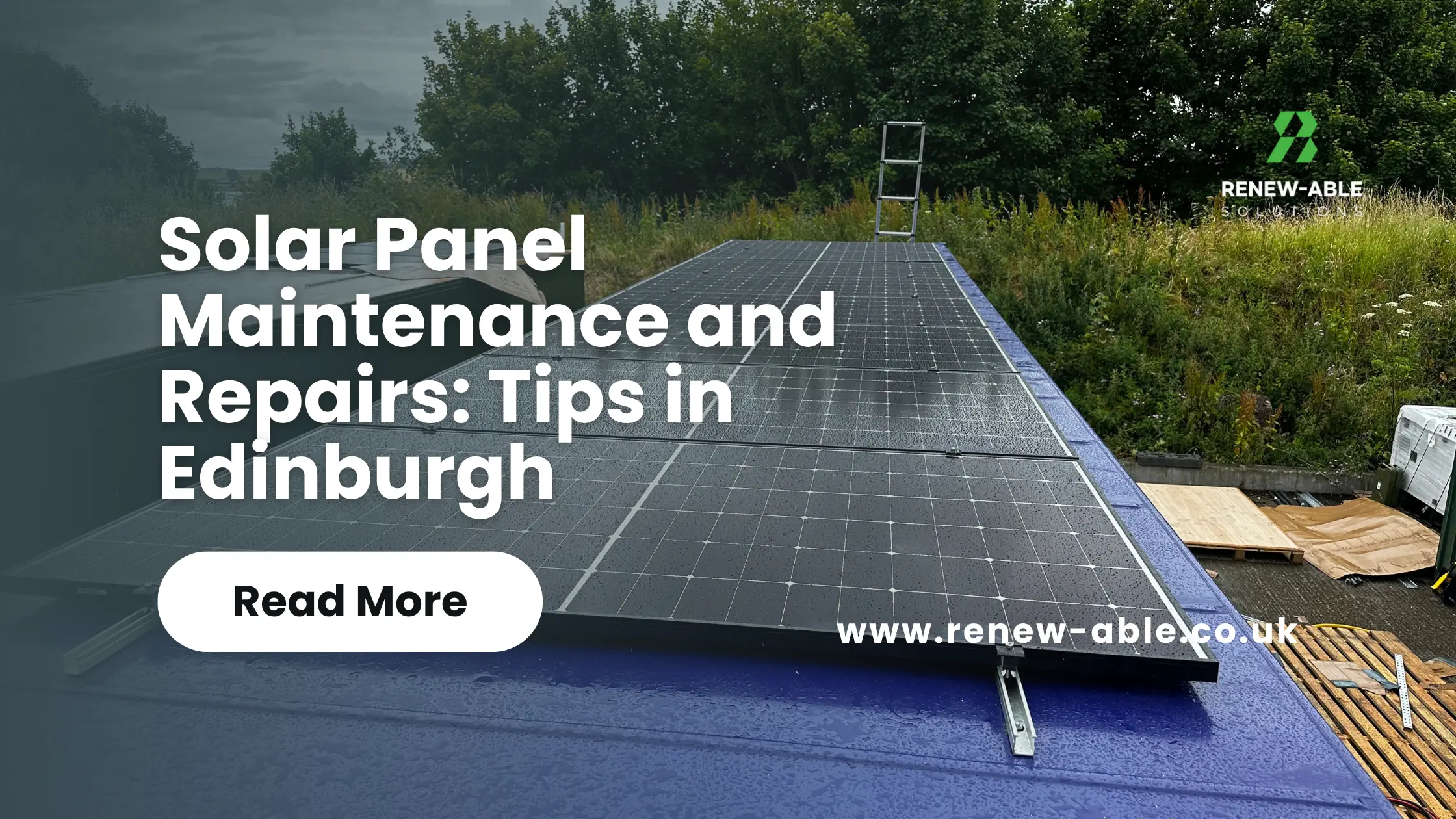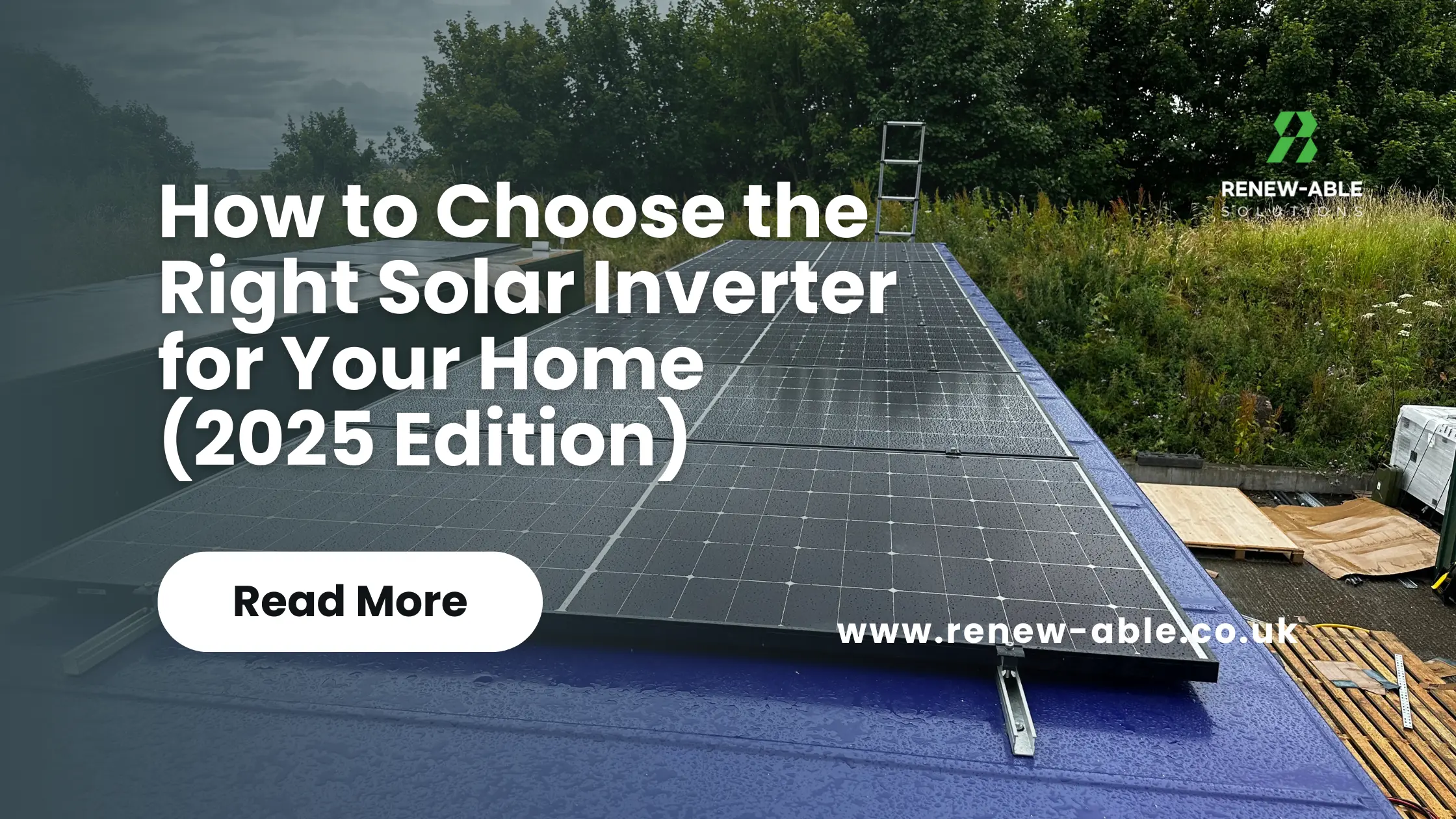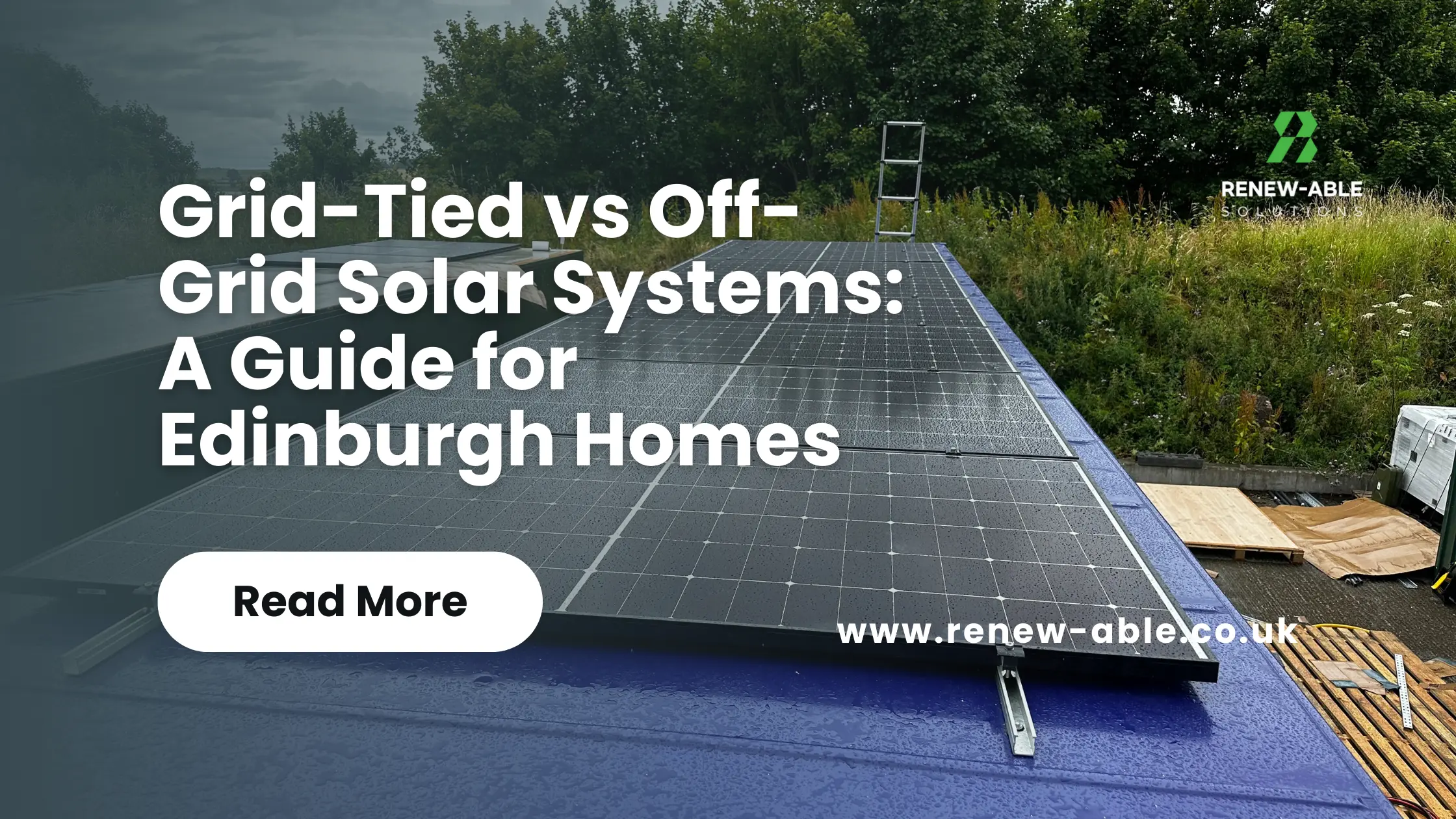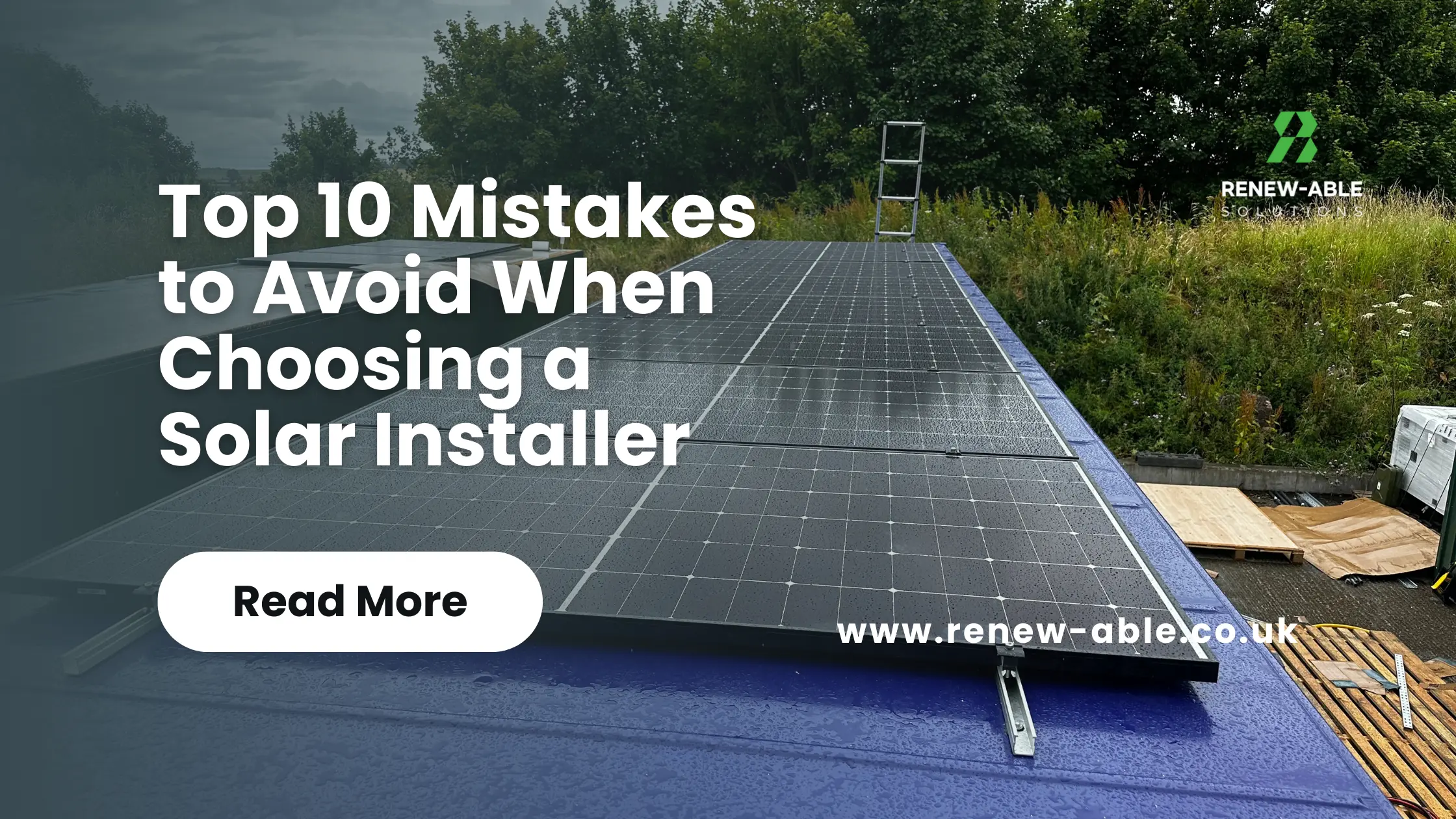WHAT IS A SOLAR BATTERY
A solar battery, similar to any kind of battery, simply stores energy. By storing your solar energy within a solar battery, you end up with a supply of green energy to use whenever your home needs it. Which comes extremely handy during the evening and night, when your solar panel system isn’t able to generate as much power. The benefits of home battery storage speak for themselves, but which solar battery to choose becomes a pressing question.
WHO MAKES SOLAR BATTERIES
With big names such as Tesla and Duracell entering the energy game, the list of solar battery suppliers is growing rapidly.
Here at Renew-Able Solutions, we install battery storage systems made by Growatt, GivEnergy, Sofar, Aton, Victron and Solax Energy.
HOW DO I KNOW WHICH SOLAR BATTERY IS THE BEST?
Depending on which features you wish to prioritise, the best solar battery can differ project to project. Lucky for you, the team here at Renew-Able Solutions have put together a list of key features to compare before choosing which solar battery to install.
BATTERY CAPACITY – KWH
Battery size, also known as Capacity, is the maximum amount of energy in kilowatt-hours, that a battery can store at a given time. Some solar batteries such as the Growatt 3.3kWh are scalable. This means you can add more energy storage gradually, and increase your battery’s capacity over time. Solar batteries come in a range of capacities, the larger the battery capacity the more expensive the batteries tends to be. In the UK, the average household uses around 8-10 kWh of electricity every day. However, the capacity of storage your project will require all depends on your energy consumption. As a solar battery should never be fully discharged, the “useable capacity” indicates the truthful amount of energy a battery can store.
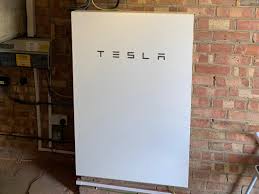
LIFECYCLE
Solar Battery Storage with Back Up Power EPS – A battery’s life cycle indicates the lifespan of a solar battery. Similar to a phone or laptop battery, a solar battery can only be fully recharged and emptied a certain amount of times. Therefore, the larger amount of lifecyles a solar battery is able to perform the better! As the average lifespan of Solar Panels is 15 years, ideally you would want an energy storage system that can match it. Many solar battery manufactures offer warranties that guarantee a certain level of performance after a certain number of cycles.
DEPTH OF DISCHARGE (DOD)
Depth of Discharge is the maximum percentage of a battery’s capacity that is useable without the need for a recharge. Although a battery will state a capacity, you will never be able to use that full amount. This is because draining a battery completely can damage the battery itself. The Depth of Discharge is there to help you understand how much of the battery’s total capacity can actually be safely used. For example, Growatt’s 6.5kWh battery has a depth of discharge of 94.5%. This means that although its total capacity is 6.5kWh, only 6.14kWh can be use before recharging, otherwise the battery can get damaged. Hence why on the Growatt’s 6.5kWh datasheet the usable capacity is 6kWh.
To conclude, the higher the Depth of Discharge, the more of your battery storage you can actually consume on a day to day basis.

CHARGING/DISCHARGING CURRENT
A batteries’ charge rate is the rate of time it takes to charge or discharge in Amps. The charge/discharge rate is calculated by dividing the capacity of the battery by the number of hours it takes to charge/discharge.
Most common UK and EU households will use low voltage batteries with a discharge/charge rate of 3kW. High Voltage solar batteries, which are not common residentially, have a 5kW charge/discharge. A higher charge/discharge rate means that your solar battery is capable of handling higher base loads and surges.
SMART GRID TRADING
Some solar batteries such as Moixa, GivEnergy and Solax, allow for autonomous grid trading. Smart, automatic grid trading, takes the control out of the user’s hand and puts it into the hand of artificial intelligence. Trained specifically to save you money. Batteries that allow for autonomous grid trading take advantage of tariffs such as Octopus Agile or Social Energy. The integrated AI automatically charges your battery from the grid when the cost per unit of energy is low. This not only improves the balance of renewable energy on the National grid network but also reduces your green energy waste. Allowing other connected users to power their home on your clean energy.
TECHNOLOGY
Similar to the battery technology found in your electric vehicles, tablets and phones, many solar batteries are Lithium-ion based. Known for their low life-time cost, and higher efficiency, lithium-ion batteries are seen as the batteries of the future. The most modern Lithium ion technology used in solar batteries is Lithium ion phosphate (LiFePO4 or LFP). Compared to lead-acid batteries and other lithium batteries, LiFePO4 batteries have a longer life span. They also have an improved discharge and charge efficiency, are lightweight and extremely safe.
Lead acid batteries still remain popular amongst homes looking to go off-grid, with a cheaper upfront cost.
MONITORING
Monitoring platforms such as Shine Smart Monitoring, make it possible for users to view and monitor their energy usage. By gaining access to this data, each customer is able to view how much energy is being stored in their battery. The user will also be able to see whether or not their battery is charging, and how much energy their solar PV system is generating. These monitoring platforms are usually accessible via an app on your phone or web browser.
To some users the ability to see how they are using their energy is invaluable, for less tech savy users this feature isn’t as important.
AC VS DC BATTERY SYSTEMS
There are two types of battery installation systems, known as DC and AC coupling. AC or DC coupling refers to the way solar panels link to a solar battery or energy storage system. The key distinction between an AC-coupled and DC-coupled battery system lies in the journey the electricity takes. A DC battery system is more efficient in converting solar energy, as it connects your PV system directly to the solar panels. Whereas, an AC-coupled system connects your solar panels directly to an inverter. As a result, any electricity stored in a battery system is effectively inverted three times.
Read more about AC & DC Batteries to understand what works for you.
POWERCUT SUPPLY
Despite popular belief, not all solar batteries are capable of supplying energy during a power-cut. As your solar panels and battery connect directly to the main grid, your solar inverter will automatically switch off your system during a power cut. This is so that it is safe for the engineers to work on the grid. However, if your solar battery has back-up storage functionality you can still gain power.
Solar batteries which have back-up functionality have an auto transfer relay switch. As your solar panel system detects a drop in voltage on the grid, your home will automatically disconnect from the grid. Connecting to your solar back-up supply instead. This is referred to as islanding. Islanding relies on a hybrid solar solution to provide an Emergency Power Supply (EPS). An EPS is designed to power your essential circuits during a power cut, and is usually priced as an upgrade. A hybrid solution with EPS, will still allow the batteries to charge from your solar when there is no grid supply.
WARRANTY
Just like any household appliance, solar batteries also come with a warranty. The warranty of a solar battery is often an indicator of how long you can expect your home battery to last. Defined by the number of cycles the battery is able to complete. Usually, more expensive batteries include longer warranties, as the battery is more durable.
SOLAR BATTERY COMPARISON
Below our green team have put together a comparison table for some of the battery storage systems available on the market. If you would like to find out more information regarding solar batteries contact our team on 0131 210 0405.
| Solar PV Battery | Storage Capacity (kWh) | Depth of Discharge | Useable Capacity (kWh) | Price | Warranty | Power Cut | AC or DC Coupled | Monitoring | Smart Charging | Indoor or Outdoor | Flexible Storage | Technolgy |
|---|

 | 2.4kWh | 90% Depth of Discharge | 2.2kWh | £3995 Retro Fitted | 10 Years | Yes | Yes | LiFePO4 | ||||
 | 2.56kWh | 90% Depth of Discharge | 2.3kWh | ££ | 10 Years | Shine Smart Monitoring | IP65 – Indoor & Outdoor | Yes 2.56kWh up to 25.6kWh (10 Batteries). | Cobalt Free LiFePO4 | |||
 | 3.3kWh | 93% Depth of Discharge | 3.1kWh | £4850 Retro Fitted | 10 Years | Shine Smart Monitoring | IP20 – Indoor Only | Yes 3.3kWh up to 19.8kWh (6 batteries). | LiFePO4 | |||
 | 3.3kWh | 90% Depth of Discharge | 3kWh | £££ | 10 Years | Yes | Social Energy Compatible | IP32 – Indoor Only | Yes, Scalable up to 6kW | LiFePO4 | ||
 | 5.12kWh | 80% Depth of Discharge | 3.5 kWh | £5750 Retro Fitted | 10 years | Yes – 3000VA | DC | Solarman Monitoring | IP20 – Indoor Only | Yes Up to 4 18.4kWh per inverter. (4 Batteries) | LiFeP4 | |
 | 5.8kWh | 90% Depth of Discharge | 5.22kWh | £6950 Retro Fitted | 10 Years | Yes | Social Energy Compatible | IP55 – Indoors & Outdoors | Yes Scalable 23kWh of storage. (4 Batteries) | LiFePO4 | ||
 | 6.5kWh | 92% Depth of Discharge | 6kWh | £6250 Retro Fitted | 10 Years | Shine Smart Monitoring | IP55 – Indoors & Outdoors | Yes up to 13kWh (2 Batteries) For 6531 Model. Up to 52kWh (8 Batteries) for 6532 ( Newer Model) | LiFePO4 | |||
| 8.2kWh | 100% Depth of Discharge | 8.2kWh | £££ | 10 Years | Yes – With Additiona Costs | DC | GivEnergy Monitoring Portal | Octopus Energy Compatible | IP65 – Indoor & Outdoor | Yes | LiFePO4 | |
| Tesla Powerwall | 13.5 kWh | 100% Depth of Discharge | 13.5kWh | £££ | 10 Years | Yes | Tesla Monitoring |


